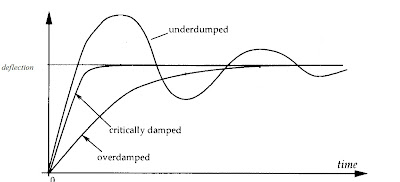Essentials of Indicating instruments : An indicating instrument essentially consists of a moving system pivoted in jewel bearings. A pointer is attached to the moving system which indicates the electrical quantity to be measured, on a graduated scale. In order to ensure the proper operation of the indicating instruments , the following three torques are required.
- Deflecting (or operating) torque.
- Controlling (or restoring) torque.
- Damping torque
Join EEE Made Easy Telegram channel
Essentials of Indicating instruments
The deflecting torque is produced by utilising the various effects (magnetic effect, induction effect, thermal effect, hall effect) of electric current or voltage, and causes the moving system and hence the pointer to move from zero position.
The controlling torque is produced by spring or gravity and opposes the deflecting torque. The pointer comes to rest at a position, where these two opposing torques are equal.
Damping torque is provided by air friction or eddy currents. It ensures that, the pointer comes to the final position, without oscillations, thus enabling accurate and quick readings to be taken.
Deflecting torque(Td)
The deflecting torque causes the moving system to move from zero position to indicate the value of the electrical quantity being measured on a graduated scale. The actual method of producing the deflecting torque depends upon the type of instrument.
Controlling torque(Tc)
If the deflecting torque were acting alone, the pointer will continue to move indefenitely and would swing over to the maximum deflected position irrespective of the magnitude of the electrical quantity to be measured. This necessitates providing some form of controlling or opposing torque. This controlling torque should increase with the deflection of the moving system. The pointer will be brought to rest at a position where the two opposing torques are equal. ie, Td = Tc .
The controlling torque performs two functions.
a) It increases with the deflection of the moving system so that, the final position of the pointer on the scale will be according to the magnitude of the electrical quantity to be measured.
b) It brings the pointer back to zero position, when the deflecting torque is removed. If it were not provided, the pointer once deflected would not return to zero position on removing the deflecting torque.
The controlling torque can be provided,
Ø by using one or more springs
Ø by the weight of moving parts.
Damping torque (Tdamp)
If the moving system is acted upon by deflecting and controlling torques alone, then due to inertia, the pointer will oscillate about its final deflected position for some time before coming to rest. This oscillation makes it difficult to obtain quick and accurate reading. Inorder to avoid these oscillations of the pointer and to bring it quickly to its final deflected position, a damping torque is provided in the indicating instruments. The damping do not affect the stationary pointer, as the damping torque acts only when the pointer is in motion and always opposes the motion.
The damping torque in indicating instruments can be provided by,
Ø Air- friction
Ø Fluid friction
Ø Eddy currents
The behaviour of the moving system is decided by the degree of damping. The fig. given below shows the graph for under damping, over damping, and critical damping.

Under damped moving system:- The pointer will oscillate about the final position for some time, before coming to rest.
Over damped:- The pointer will become slow and lethargic.
Critically damped/ dead beat:- The degree of damping is so that, the pointer comes up to the correct reading quickly without passing beyond it or oscillating about it.
………………………………………………………………………………………………….. Reference:-
(i) A.K Sawhney, Electrical and Electronic Instrumentation and Measurements, page no:- 225
(ii) V.K Mehta, Rohit Mehta,Basic Electrical Engineering, page no:- 769- 773
…………………………………………………………………………………………………………….
Join EEE Made Easy Whatsapp Channel
- [PDF]Electrical Measurements Measuring Instruments Study Notes PDF|EMMI Notes EEE Made Easy
- MCQ on Electrical Instruments
- Types of Errors in Instruments| Instrument Errors
- MCQ’s on Electrical Measuring Instruments|Instruments Objective Questions
- Electrical measuring instruments|Types of Measuring Instruments
- Static characteristics of instruments
- Types of measuring instruments- www.eeemadeeasy.com
- Moving Iron Instruments
- Instruments- Basics
- PMMC Instruments
- Types of instruments
- Essentials of Indicating instruments
- MCQ’s on Galvanometer|Galavnometer Questions & Answers
- MCQs on potentiometer|potentiometer Questions and answers
- TOD Meter or Time of Day Meter
- Light meters or illumination meter|Lux meter
- VU and decibel meters
- Multimeter- Principle and operation
- Digital readout meters-principle and operation
- Watt-hour meters- principle and operation
- Wattmeter -principle and working
- FET and vacuum-tube voltmeters
- Ohmmeter- basic principle and working
- Ammeters|Current Measurement
- Voltmeter- Principle and operation
- The household energy meter is
- Q Meter
- Thermistor| What is a Thermistor
- RTD vs Thermistor|Comparison between RTD and Thermistor
Latest Posts in EEE Made Easy
- Environment MCQ for RRB JE CBT 2|Objective Questions Environment for Competitive Exams
- RRB JE CBT 2 Computer Awareness Book Arihant|Objective Computer Awareness Book 2025
- RRB JE CBT 2 Exam Date 2025 Postponed|RRB JE CBT 2 Exam Date
- [PDF]RRB JE Result 03/2024 Cut off, Selected no of candidates for all regions
- [PDF]Final Answer Key Junior Instructor Mechanic Agricultural Machinery|643/2023 Solved Question paper
- Acoustics MCQs|Industries Extension officer|IEO 2025
- LASER MCQs| Industries Extension officer|IEO 2025



